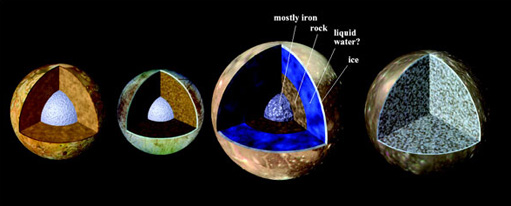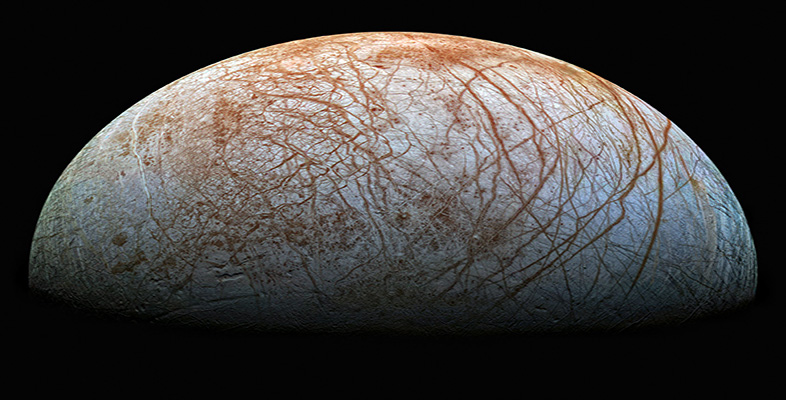1.5 The Galileo mission
It was a long time before the Voyager missions were followed up by more detailed surveys of the outer planet satellites. No Uranus or Neptune missions are planned, but a mission to Saturn called Cassini-Huygens was launched in 1997 for arrival at Saturn in 2004. However, the Jupiter system received a similar visitor first. This was Galileo, launched in 1989, which became the first spacecraft to orbit Jupiter in December 1995. It continued to function through 2002, and was destroyed by plunging into Jupiter's atmosphere in September 2003. This was a planetary protection measure, taken to avoid the possibility of the defunct craft eventually colliding with Europa and thereby contaminating it with any unintentional bioload.
Galileo had several close encounters with each of the Galilean satellites, providing more complete and more detailed imaging than was possible during the Voyager fly-bys, using an instrument known as the solid-state imaging (SSI) camera. It also carried a near-infrared imaging spectrometer (NIMS), which was useful for determining surface compositions (and also temperatures of Io's active lava flows), an ultraviolet spectrometer, and magnetometers that revealed the satellites' responses as they move through Jupiter's magnetosphere. (Near-infrared means the part of the infrared spectrum that is nearest to the visible. The actual spectral range covered by NIMS was 0.7-5.2μm.) Perturbations to Galileo's trajectory as it passed close to the satellites placed improved constraints on their internal density distributions, indicating dense, presumably metallic, cores at the centres of Io, Europa and Ganymede. Callisto, by contrast, was proven to be only weakly differentiated, with incomplete segregation of rock and ice (Figure 14). See Box 3 for a discussion of how terms are borrowed from the terrestrial planets to describe the compositional and mechanical layers within icy satellites.

Box 3: Terminology for the layered structure of differentiated icy bodies
In a differentiated terrestrial planet, the term core is used for the dense compositionally distinct inner part, which is rich in iron. This is surrounded by a rocky (silicate) mantle. The extreme outer part of the rocky material is referred to as the crust if its composition has been altered by volcanism and other recycling processes.
In a differentiated icy body, it is logical, by analogy, to regard the rocky interior as the core (and if this is itself differentiated, with an iron-rich centre, to call that the inner core). The icy outer part of such a body is thus the mantle, and if the outer part of the ice differs somewhat in composition from the interior, we can call this the crust. The analogy is particularly apt because Solar System ices share many important properties with silicate rock. Among these are:
At the prevailing near-surface temperatures, the ice is mechanically strong and rigid, like rock near the Earth's surface.
When caused to melt (by heat, or in some cases a decrease in pressure) ice that is water mixed with salt or water mixed with another volatile species undergoes partial melting, just like a mixture of silicate minerals in rock. The melt and the surviving crystals have different compositions, and melting begins at a lower temperature than for pure water-ice.
At sufficient temperatures and pressure, ice will flow without melting, and can undergo solid-state convection, just like rock in the deeper part of the Earth's mantle.
Property 2 in this list makes it likely that the outermost part of a differentiated icy body does indeed differ at least slightly in composition from its mantle, and so we can regard this differentiated ice as a true crust. Property 3 means that we can discriminate the outer rigid ice (upper mantle plus crust) from the deeper more mobile (even though solid) ice, and distinguish these by the terms lithosphere and asthenosphere, respectively, which were originally coined for the Earth.
Relying largely on Galileo observations, we will now take a detailed look at Europa, to see what we can deduce about its recent history and the possibility of a life-bearing ocean below the ice.
